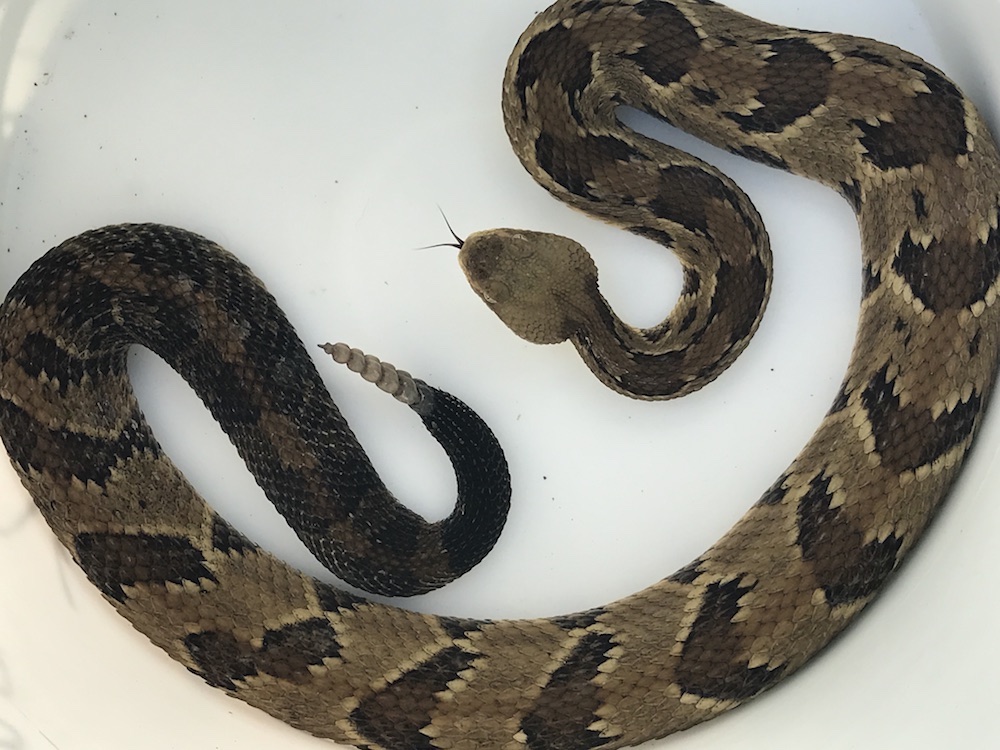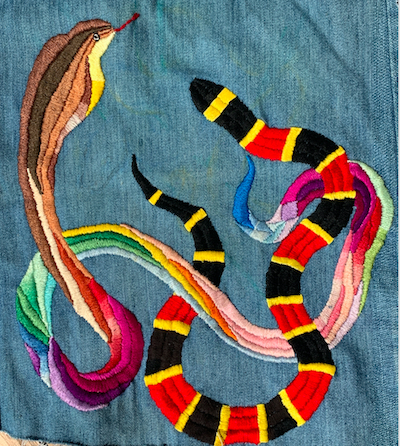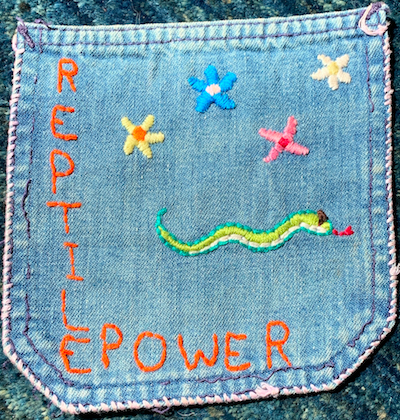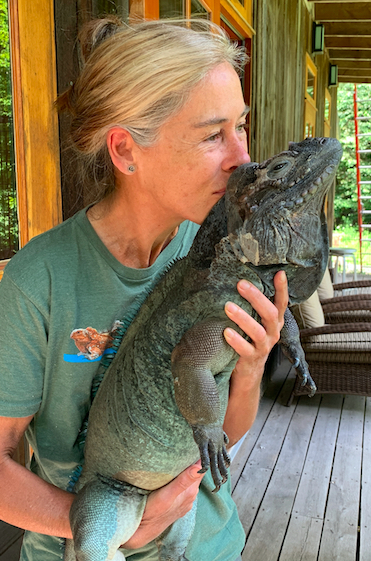Essay by Wendy Townsend
A Passion for Reptiles—and a Desire to Save Them

I want us to love rattlesnakes.
Good luck with that. In the summer of 2018, I gripped my pen and narrowed my eyes. I’d read somewhere, probably in a writing blog, that people want to read things that make them breathe easier. So, I crossed out a sentence about studies showing there’s more Lyme disease where rattlesnakes have been wiped out. My office buddy, a Cuban rock iguana named Che, looked on without comment.
My story about timber rattlesnakes had no publisher or deadline, but I felt an urgent need to get down on paper who rattlesnakes are. I still do. I’m sick of hearing about how reptiles have small brains and can’t love life or have any of the feelings about life we do, that they only have base survival instincts. That’s a heap of bs.
In our Catskills barn, only the two bathrooms have doors. My office is in the upstairs one. It’s a big room, with a claw-foot tub, a toilet, a radiant-heated slate floor, my desk tucked in the corner, and Che’s basking shelf in the dormer window. Che lets me know when he wants to go out. He’ll climb down his ladder and stand by the door, peering at me. He’s the size of a small cat, speckled chocolate brown, black, and coffee-with-milk.
Every summer day, I also get my lizards out to their sunning cages. I scoop Che up in my arms and carry him past Ava, my rhinoceros iguana, who often waits at the foot of the bed by the double doors that open onto the deck. Luna, the female Cuban, has her own basking shelf with lights and sleeping box in the mudroom. I carry her to her cage next to Che’s. This is when they get to see each other, bobbing heads and making faces. (They have separate rooms, because they’re like the Bickersons and sometimes bite each other.)
I have five lizards total, all West Indian rock iguanas purchased from a breeder. When Sebastian claws at his corral gate, I carry him to his cage, and then I take Emo out to his. It’s a morning ritual. Once all the lizards are in their sunning cages, I can return to my desk and write another hour or two before fixing their breakfast of edible weeds I’ve foraged, plus dandelion and turnip and collard greens with blueberries and mango.
That’s an easy day with my lizards.
When I speak or write about reptilian emotion, I’m often accused of being too anthropomorphic. Writer and naturalist Sy Montgomery has been accused of the same thing, whether she’s discussing dolphins, chickens, or octopuses in her books. In a 2019 review of primatologist Frans de Waal’s Mama’s Last Hug: Animal Emotions and What They Tell Us About Ourselves, Montgomery argues back:
Emotions are neither invisible nor impossible to study; they can be measured. Levels of chemicals associated with emotional experiences, from the ‘cuddle hormone’ oxytocin to the stress hormone cortisol, can easily be determined. The hormones are virtually identical across taxa, from humans to birds to invertebrates.
I’ve kept snakes as well as green iguanas since I was a kid, but when my oldest and last boa constrictor died twenty years ago, I didn’t get any more snakes as pets. But I love snakes—so much so that I wanted to be a herpetologist or field biologist. But after dropping out of four biology programs, I figured the hard sciences weren’t for me, and I was kept plenty busy with animal care and jobs to pay rent. Then I went on to earn my MFA, writing fiction for young readers.
After Blue Iguana, my last YA novel, came out in 2014, I tried to write another about a reptile-loving kid finding her way. This time, though, friends and colleagues told me it should be a memoir. I assumed a memoir had to be about my whole life, with all the jobs and boyfriends and dropping out of college, and the first draft was terrible.
But driving home from a writing workshop in the summer of 2017, I saw a giant sea turtle on a billboard looming against the backdrop of the Appalachians. The caption read: Be a voice for those who have no voice. I knew then what I needed to do.
I revised my memoir draft with reptiles at the center, and it started to flow. I began wearing my lizard earrings and “Rise Against Rattlesnake Roundups” and “Iguana Specialist Group” T-shirts all the time—and as if the Universe noticed my effort, I was given a job as a reptile monitor.
• • •
I wouldn’t say that I was bullied, but I was the only child of a teen mom from the Midwest plopped down in Queens, New York. Still, I was fortunate enough to return to the family cottage in northern Michigan every summer. Once, my great-grandmother and I were out picking wild strawberries when I found a smooth green snake coiled in part of a rotting log. I wasn’t yet five years old. I touched his soft green scales and looked into his gold eye with its round black pupil.
Back in the city for the school year, I had my pet snakes and green iguanas, and I had a favorite book called Snakes of the World. I especially loved the venomous snakes. Not only did most of them come from faraway places, they were colorful with keeled or smooth scales; they had structured, sculptural bodies; they had heads I longed to touch and eyes I wanted to see for real. Reading about them, I could tell these snakes were both fierce and shy like me. Plus, there were all the other cool details: how pit vipers bear live young or cobras lay eggs in nests they guard.
 I had a set of a hundred colored pencils and a thick sketchbook in which I made meticulous copies of the photos and drawings in the Snakes book and wrote the scientific names underneath. I got excited every April, telling my mother, “Guess what? In India, the king cobras are making their nests and laying eggs!”
I had a set of a hundred colored pencils and a thick sketchbook in which I made meticulous copies of the photos and drawings in the Snakes book and wrote the scientific names underneath. I got excited every April, telling my mother, “Guess what? In India, the king cobras are making their nests and laying eggs!”
Broad-sided by puberty, desperate for acceptance, I embroidered snakes and lizards on my jeans and wore them to school. One day, Martha Smith, girl-pack leader in our little Quaker school and the principal’s daughter, came up to me. Like her father, she had thin lips and a serious face all the time.
She looked at me with her small blue eyes. Then Martha said with Quaker-peaceful matter-of-factness, “We think you’re really weird.”
• • •
Since April 2018, I’ve worked as a reptile monitor in the Northeast. My job is to keep threatened snake and turtle species out of harm’s way on utility construction and repair sites. If heavy machinery is disturbing the ground within range of a rare turtle habitat or a rattlesnake den, the law requires a reptile monitor to be present during work hours.
On one of my first jobs, I sat with the boss in the construction-site trailer, following him in after he’d parked his shiny black Mercedes outside. He’d already told me he didn’t like snakes, but he still asked if I’d seen any. He knew how much I wanted to.
One morning that early spring, we stood by the pond, shivering in our jackets. “No snake stick?” he asked.
“It’s too cold, snakes aren’t out.”
“I don’t know why all the fuss to save these snakes, when all they do is kill people.”
I stared at the log where painted turtles would be lined up if it were sunny.
He kept talking. “I have grandchildren. I see one of these snakes in my yard, and you better believe I’m getting a shovel, and that snake is dead.”
I couldn’t speak. I imagined that rattlesnake coiled in defense while a creature fifty times her size towered over her with a shovel. My heart sped up with dread and grief for her violent death, as if it were my own.
That snake wanted to live. The man did not know who she was.
He and anybody else who sees a venomous snake can call wildlife control instead of killing one. In fact, people get bitten when they try to kill a venomous snake, when a professional could have removed the animal with no harm done to either.
Rattlesnakes want to live.
New York State’s bounty on timber rattlers ended in 1971, and the snakes there currently have threatened status. In the past century, more than half of longtime rattlesnake dens have been wiped out in New York. And since females give birth only once every three to five years to nine or so young, recovery of some dens is uncertain at best. Habitat loss, cars, and people killing them out of fear remain the biggest threats to rattlesnake survival.
While it’s true that untreated bites can be fatal, timber rattlesnake bites are rare, and there’s plenty of time to get to a hospital for antivenin treatment. It’s a different story in Swaziland (Eswatini), where venomous snakes like the black mamba are potentially far more dangerous. In a population of 1.2 million, 200 people are bitten each year. Yet even there, humans are the problem. Encounters with snakes have increased, in part, because snakes come to hunt rodents that are attracted to human settlements. Up to 80 percent of bites occur in rural areas, which lack hospitals equipped with antivenin.
The 2009 PBS show Black Mamba featured Swazi-born Thea Litschka-Koen and her work with venomous snakes. On the website for the show, Litschka-Koen answers questions from viewers, including one about “educating people in Swaziland.” When a child has died from a snakebite, she says:
The family members want me to kill the snake immediately. They want revenge! The hatred is often palpable. Can I blame them? No.
But she goes on to describe the educational outreach she’s doing to “prevent unnecessary snakebites and, at the same time, conserve our wonderful reptile population." It’s about coexistence. When people know snakes better, lives are saved, both human and snake.
• • •
Later in that first monitoring season, at one of the sites I really liked, I would get to work at 7:00 a.m. sharp, put on my day-glow vest and hardhat, and grab my snake stick. I’d look under heavy machinery and around the huge tires and tracks to make sure no snakes had crawled there to hide. Then I’d climb down in the pits and trenches to make sure none had fallen in.
I often gathered up frogs, toads, newts, and garter snakes to release outside the work area. I’d spend the day walking the site, lifting the corners of tarps with the hook tip of my stick, bending to see under stacked construction materials. I walked the site access road where trucks and machinery would come and go, watching for reptiles on the move.
The guys on the crew made up names for me, which I enjoyed. With my vest and stick, I was the “snake-wrangler” or “snake police” or “viper lady.” They’d ask, “See any snakes?” many times each day.
I’d tease, “No! You’re scaring them away!”
“Good,” one guy told me. “I don’t like snakes, but I wouldn’t kill any. I just leave them alone.”
I liked his response. On most job sites, at least some of the guys were glad I was there, watching out for their safety as well as the snakes’. When they wanted to move a pallet of materials, they’d call on me to oversee. They counted on me to check the pits and trenches, and they saw that I cared about my work and did my job as they did theirs. And if I did find a rattlesnake, it would spark up the day.
“See any snakes?” A guy moving gravel with a skid-steer stopped.
“No, but it’s supposed to warm up this afternoon, so keep an eye out.”
“I always do,” he said. “I hate mice. They chew the wires in my home. Do a lot of damage. So when I see one of those rattlers in my yard, I get a shovel and help him along over the fence.”
“That’s great!” I gave a thumbs up.
He nodded, put his machine in gear, and kept going.
• • •
One sunny afternoon in September, I walked the same site, looking over the break area where guys smoked cigarettes and drank coffee. I’d already checked it twenty times that day. But on the twenty-first pass, I saw the edge of yellow-and-brown-patterned coils under a pallet of stacked boxes filled with pipeline hardware.
Speed walking to my truck, I planned how I’d move that snake. He knew he’d been seen. I grabbed my five-gallon compound bucket with air holes and writing on it in big black letters: Venomous snakes, Do NOT open!
The guys stood in a semi-circle ten feet back. The snake had pulled himself mostly under the pallet and was peeking out, flicking the air with his tongue. The only rattlesnake handling I’d done on the job so far was escorting one across the access road and helping another up and over the silt fence.
 But I was calm. It was just the snake and me. I slipped the tip of the hook under his coil and eased him out, up, and down into the bucket. I got the lid on gently. I did it in one fluid motion, as if I’d been doing it all my life.
But I was calm. It was just the snake and me. I slipped the tip of the hook under his coil and eased him out, up, and down into the bucket. I got the lid on gently. I did it in one fluid motion, as if I’d been doing it all my life.
The guys were smiling and nodding, before they broke it up and went back to work. I took my bucket of precious cargo and headed for the opposite end of the site in the direction of the den, which was less than a quarter mile up the hill.
Carrying my bucket, I was a little kid and couldn’t suppress it, and the site boss saw. He was a Texan who drove an immaculate, tricked-out white pickup truck, and he neither hated nor loved rattlesnakes. But he grinned and fist-pumped the air as I went by.
Before tipping the bucket to release the snake, I took out my iPhone for a photo. Then I saw that “he” was a she. I noted the shorter distance between the base of the rattle and the slight narrowing where the cloacal vent was. When I snapped the photo, she rattled once, lightly, as though more from nervousness than to warn.
“Sorry.” I leaned the bucket away from myself.
She slid out and went uphill into the ledge rocks that were secondary basking sites. My heart felt soft and happy-sad, as if I were a child again, like the time I let go of a water snake by a pond in Michigan.
• • •
Snakes were here long before us, yet I don’t feel like a trespasser among their rocks and dens. I feel their acceptance and my own belonging on earth. I’m admitting my reptile love outright here, because I could never hide it completely anyway. At times, I wore it like armor—like scales—to protect myself from people’s feelings about reptiles or about me.
And none of that has helped me write with power about the animals I love.
Recently, as I headed into my office, I stopped. Emo was watching me from his basking shelf in the dormer across the barn. I’d been at work the day before, too busy to do more for him than put down food. Now, I set my coffee cup on my desk and went to Emo’s corral. His hardened gray eye looked into mine. I could tell he was angry. With his muscular armored head and scaly lips, which hid many small sharp teeth, he was both rhinoceros and velociraptor. There’s not much that’s soft on Emo, and I understand how a lot of people see only meanness in reptiles.
But when I opened the gate and stepped inside, putting my hands on Emo, his eyes softened and slowly closed. He jacked himself up like a cat being petted, while I told him I was sorry I hadn’t had enough time lately.
I think about the site boss killing a snake, about him asking “why all the fuss” to save rattlesnakes. I can’t just write that I love them. There has to be a big reason, I tell myself, something sweeping, something to convince this boss and other humans.
The forest without rattlesnake dens is diminished, having lost its power to affirm our connectedness to all life. I could write this. I know it’s true. But instead, I’ll say that rattlesnakes don’t slither around in the woods looking for people to bite. They winter in ancestral dens, they have families, they leave scent trails for each other so they don’t lose their way home.
What happened to our empathy? We’re creatures with so little compassion, yet we wield so much power, and this astonishes me. The Universe messed up there. Rattlesnakes have lives—and they have the right to live their lives just as we do.
Publishing Information
- “Timber Rattlesnakes Indirectly Benefit Human Health: Not-so-horrid Top Predator Helps Check Lyme Disease,” Science Daily, August 6, 2013.
- “Frans de Waal Embraces Animal Emotions in ‘Mama’s Last Hug’” by Sy Montgomery, New York Times Book Review, February 25, 2019.
- “Timber Rattlesnake Fact Sheet,” New York State Department of Environmental Conservation.
- “Timber Rattlesnake,” New York National Heritage Program.
- “Swaziland: 200 Bitten by Snakes Yearly,” APA News, November 21, 2017.
- “Snake Handler Thea Litschka-Koen Answers Your Questions” (about Black Mamba), PBS, November 6, 2009.
Art Information
- “Timber in My Compound Bucket,” “My Cobra and Coral Snake Embroidery,” and “Embroidered Jeans Pocket (Reptile Power)” © Wendy Townsend; used by permission.
 Wendy Townsend is a graduate of the Vermont College MFA Program in Writing for Children and Young Adults. She’s a lifelong lover of animals and has lived with many large lizards since she was eight years old. In 1993, she coauthored a biology and husbandry book about iguanas and has written many articles about these lizards.
Wendy Townsend is a graduate of the Vermont College MFA Program in Writing for Children and Young Adults. She’s a lifelong lover of animals and has lived with many large lizards since she was eight years old. In 1993, she coauthored a biology and husbandry book about iguanas and has written many articles about these lizards.
The Sundown Rule was one of Kirkus’s 2011 Best Books for Children, and her third novel, Blue Iguana, was short-listed for the 2015 Green Earth Book Award. Townsend has recently traveled to Jamaica to write about the Jamaican iguana. She is at work on a memoir called Half Lizard.
Visit Wendy Townsend’s website or follow her on Twitter @cyclura3.
